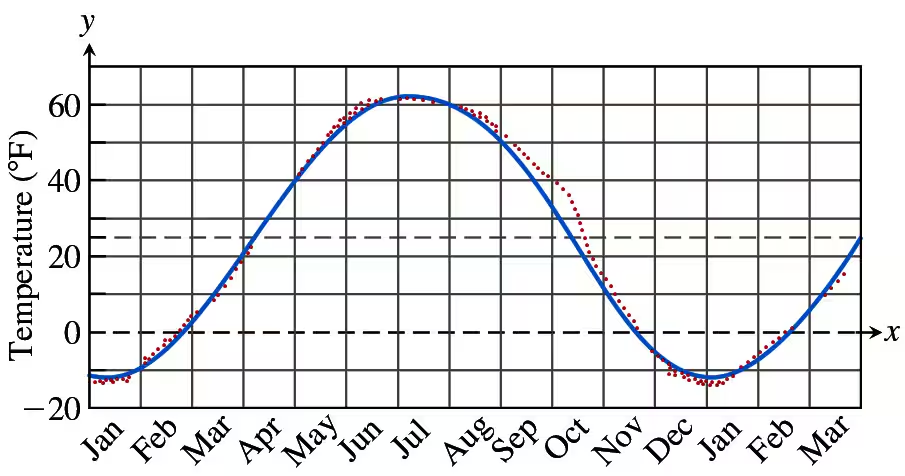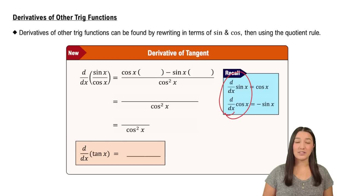Find dy/dt when x = 1 if y = x² + 7x − 5 and dx/dt = ¹/₃.
Table of contents
- 0. Functions7h 54m
- Introduction to Functions16m
- Piecewise Functions10m
- Properties of Functions9m
- Common Functions1h 8m
- Transformations5m
- Combining Functions27m
- Exponent rules32m
- Exponential Functions28m
- Logarithmic Functions24m
- Properties of Logarithms36m
- Exponential & Logarithmic Equations35m
- Introduction to Trigonometric Functions38m
- Graphs of Trigonometric Functions44m
- Trigonometric Identities47m
- Inverse Trigonometric Functions48m
- 1. Limits and Continuity2h 2m
- 2. Intro to Derivatives1h 33m
- 3. Techniques of Differentiation3h 18m
- 4. Applications of Derivatives2h 38m
- 5. Graphical Applications of Derivatives6h 2m
- 6. Derivatives of Inverse, Exponential, & Logarithmic Functions2h 37m
- 7. Antiderivatives & Indefinite Integrals1h 26m
- 8. Definite Integrals4h 44m
- 9. Graphical Applications of Integrals2h 27m
- 10. Physics Applications of Integrals 3h 16m
- 11. Integrals of Inverse, Exponential, & Logarithmic Functions2h 31m
- 12. Techniques of Integration7h 41m
- 13. Intro to Differential Equations2h 55m
- 14. Sequences & Series5h 36m
- 15. Power Series2h 19m
- 16. Parametric Equations & Polar Coordinates7h 58m
3. Techniques of Differentiation
The Chain Rule
Problem 3.6.86b
Textbook Question
Temperatures in Fairbanks, Alaska The graph in the accompanying figure shows the average Fahrenheit temperature in Fairbanks, Alaska, during a typical 365-day year. The equation that approximates the temperature on day x is
y = 37 sin[(2π/365)(x − 101)] + 25
and is graphed in the accompanying figure.
b. About how many degrees per day is the temperature increasing when it is increasing at its fastest?

 Verified step by step guidance
Verified step by step guidance1
Step 1: To determine the rate at which the temperature is increasing at its fastest, we need to find the derivative of the given temperature function y = 37 sin[(2π/365)(x − 101)] + 25. The derivative represents the rate of change of temperature with respect to time (x).
Step 2: Differentiate the function y with respect to x. Using the chain rule, the derivative of y = 37 sin[(2π/365)(x − 101)] + 25 is given by dy/dx = 37 * cos[(2π/365)(x − 101)] * (2π/365). The constant 25 disappears because its derivative is zero.
Step 3: Simplify the derivative expression. The derivative becomes dy/dx = (74π/365) * cos[(2π/365)(x − 101)]. This represents the rate of change of temperature at any given day x.
Step 4: To find the maximum rate of increase, observe that the cosine function achieves its maximum value of 1. Substitute cos[(2π/365)(x − 101)] = 1 into the derivative expression. This gives the maximum rate of change as dy/dx = (74π/365).
Step 5: Interpret the result. The maximum rate of temperature increase occurs when the cosine term equals 1, which corresponds to the steepest part of the graph. The value of (74π/365) represents the maximum degrees per day the temperature is increasing.
 Verified video answer for a similar problem:
Verified video answer for a similar problem:This video solution was recommended by our tutors as helpful for the problem above
Video duration:
4mPlay a video:
Was this helpful?
Key Concepts
Here are the essential concepts you must grasp in order to answer the question correctly.
Derivative of a Function
The derivative of a function represents the rate at which the function's value changes with respect to its input. In the context of the temperature function, the derivative will indicate how quickly the temperature is increasing or decreasing on a given day. Calculating the derivative of the given sinusoidal function will help determine the rate of temperature change.
Recommended video:

Derivatives of Other Trig Functions
Sinusoidal Functions
Sinusoidal functions, such as sine and cosine, are periodic functions that oscillate between a maximum and minimum value. The given temperature function is a sine function, which models the cyclical nature of temperature changes over a year. Understanding the properties of sinusoidal functions, including amplitude, period, and phase shift, is crucial for analyzing the temperature pattern in Fairbanks.
Recommended video:

Properties of Functions
Critical Points and Maximum Rate of Change
Critical points occur where the derivative of a function is zero or undefined, indicating potential maxima, minima, or points of inflection. To find when the temperature increases at its fastest, we need to identify the point where the derivative reaches its maximum positive value. This involves analyzing the derivative to find where the rate of change is greatest, which corresponds to the steepest slope on the graph.
Recommended video:

Critical Points

 5:02m
5:02mWatch next
Master Intro to the Chain Rule with a bite sized video explanation from Patrick
Start learningRelated Videos
Related Practice
Textbook Question
